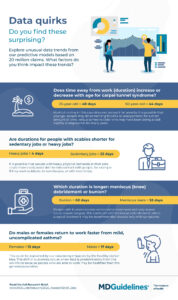Explore unusual data trends from our predictive models based on 20 million claims. What factors do you think impact these trends?
Does time away from work (duration) increase or decrease with age for carpal tunnel syndrome?
25-year-old = 48 days
50-year-old = 44 days
Medical coding in this case does not account for severity. It is possible that
younger people may do something forceful or unergonomic for a short
amount of time, versus someone older who may have been doing a task
slightly unergonomic for many years.
Are durations for people with scabies shorter for sedentary jobs or heavy jobs?
Heavy jobs = 4 days
Sedentary jobs = 22 days
It is possible that people with heavy physical demands at their jobs could more easily avoid skin-to-skin contact with people, for example, if they work outdoors, in warehouses, or with machinery.
Which duration is longer: meniscus (knee) debridement or bunion?
Bunion = 60 days
Meniscus tears = 53 days
People with bunions receive conservative treatment and only severe cases require surgery. This contrasts with meniscus debridement, where surgical treatment may be recommended despite only mild symptoms.
Do males or females return to work faster from mild, uncomplicated asthma?
Females = 13 days
Males = 17 days
This could be explained by our data being impacted by the healthy worker bias. This shift in outcomes occurs when data is predominantly from the workforce because people who are able to work may be healthier than the general population.
This topic, along with hundreds of others, can be accessed through MDGuidelines; including detailed recovery plans, timelines, and return-to-activity recommendations. Sign up for a free trial today.


